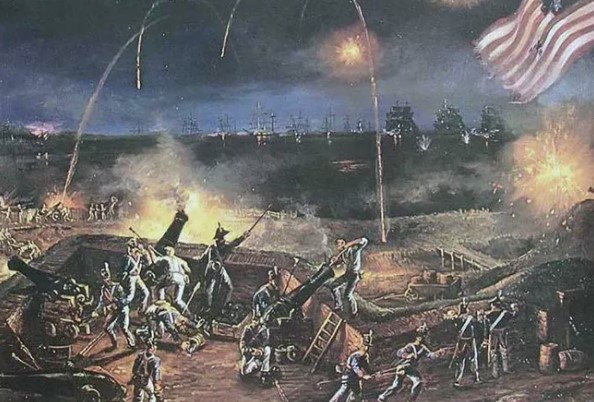The Star Spangled Banner and the Village

After witnessing twenty-five hours of heavy bombardment of Fort McHenry on September 14, 1814 during the War of 1812, lawyer and amateur poet Francis Scott Key was sure that when dawn came, the British flag would be flying over Baltimore. That was not the case, and when he saw the American flag still flying, he wrote the first verse of “Defence of Fort M’Henry,” a poem that would eventually become the national anthem of the United States.
The words were put to the tune of a popular British song, its title was changed to “The Star-Spangled Banner,” and within a few months, it was a popular nationwide hit. A congressional resolution to make it our national anthem was passed and signed into law by President Herbert Hoover on March 3, 1931.

The Village has several connections to Key and his poem that would become our national anthem as well as the flag that inspired it.
Jimi Hendrix
The Star Spangled Banner had been a fixture on the concert setlist of Villager Jimi Hendrix since August 1968. Hendrix was at the peak of his career when he unleashed his iconic version of the song to a sparse, mud-soaked audience at Woodstock on the morning of August 18, 1969.
Just one of many performers who adapted the song in their own style, Hendrix’s performance was considered offensive by some, but Hendrix believed his version was beautiful, as did many others. In many ways it came to exemplify and embody the conflict and turmoil that defined American society in the late 1960s, especially as it grappled with the growing unpopularity and brutality of the Vietnam War, as well as increasing conflict in our streets around race, poverty, sex, and politics, and the violent assassination of beloved but controversial figures like Martin Luther King Jr. and Bobby Kennedy.

On August 26th, 1970, Hendrix opened his Electric Lady Studios at 52 West 8th Street. It was the only recording artist-owned studio at the time, and it provided Hendrix with affordable studio space that would also meet his personal technical and aesthetic specifications.
Unfortunately, Hendrix, who lived nearby on both MacDougal and West 12th Streets, would pass away just weeks later, but the studio would live on and would be responsible for many of the greatest rock, hip hop, and pop albums of the last nearly half-century. The Clash, Lou Reed, Kiss, Led Zeppelin, Blondie, Run DMC, The Roots, Bob Dylan, John Lennon, Nas, Kanye West, Madonna, Beyonce, Stevie Wonder, Billy Idol, U2, Adele, Frank Ocean and Daft Punk, among many others, have recorded at Electric Lady Studios.
Socialite, Suffragist, and Singer

First daughter Margaret Woodrow Wilson was known for her bohemian spirit and career as a singer, as well as her support for the cause of women’s suffrage. As WWI raged, Margaret toured the U.S. to raise funds for the Red Cross and traveled to France to sing for the troops in war-torn France. Hear Margaret sing The Star-Spangled Banner in 1915.

After leaving the White House, Margaret moved to Greenwich Village, a place she had frequented in earlier years, residing at 134 West 4th Street.
The First Winning Temporary Insanity Defense
In April 1859, New York Congressman Daniel Sickles, who lived at 14-16 Fifth Avenue as well as 23 Fifth Avenue, became the first person in history to be acquitted of a crime due to temporary insanity. In this case, the crime was the February 27, 1859 murder of Philip Barton Key II, the son of Francis Scott Key. Key and Sickles’s wife were having an affair. “You villain, you have dishonored my house, and you must die!” Sickles was reported to say as he shot Key in the groin and then chest.

Jose Feliciano
Born on September 10, 1945 in Lares, Puerto Rico, Feliciano’s family moved to NYC when he was 5. He was born blind, taught himself how to play music, and was extremely talented. He cut his teeth in Greenwich Village venues such as Gerde’s Folk City and Feenjon’s and made it big in 1963. On October 7, 1968, Feliciano performed a beautiful but unconventional rendition of the anthem at Game 5 of the World Series in Detroit that drew mixed reviews…
Prior to Game 4, Tigers General Manager Jim Campbell warned anthem singer Marvin Gaye to “not to give too much of a soul rendition” and Gaye replied, “Yeah, I’ll sing it straight.” But such a warning was never given to Feliciano, and even if one were, it likely would have been disregarded as Felciano noted “if I’m told not to do something, I’ll do it anyway.”
The Beatnik Riot and Songs of Protest
The Star Spangled Banner was sung by many protestors in the 1960s.

The “Beatnik Riot”, or “Washington Square Folk Riot” took place on Sunday, to protest a ban on music in Washington Square Park. About 3,000 “Beatniks,” including a 19-year-old Bob Dylan, came to the park to play their music in opposition to the ban. Read more about the Beatnik Riot here. Protestors sung the anthem at this protest/riot as they believed it would prevent the police from beating and arresting them. They were wrong. Many were harassed and arrested.
The Star Spangled Banner was used as a protest song by many in the 1960s. Ever since, the flag and anthem have become contested symbols of pride and protest during struggles over civil rights, foreign policy, and cultural values. Many had thought Hendrix’s adaption was a form of protest (although he refuted this). Refusal to stand for the anthem began as a popular form of protest, mainly against the Vietnam War, in the late 1960s. This form of protest has remained a popular option to this day for those raising attention against nationalism, war, police brutality, racism, and other issues.
